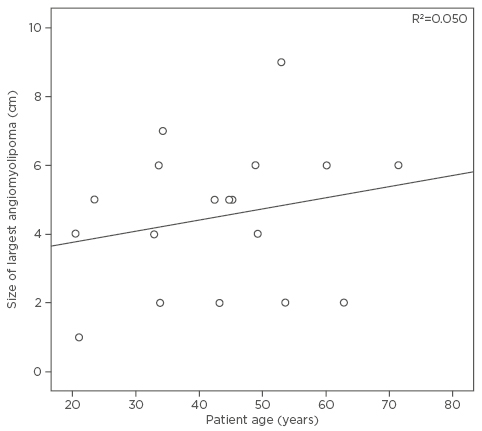Tuberous sclerosis (TS) is a rare genetic disorder affecting multiple organ systems, including the kidneys, where TS presents as angiomyolipoma (AML) and cysts.1 With the advent of mammalian target of rapamycin (mTOR) inhibitors, a new dimension has been achieved for the management of this condition.2 Our institution is a tertiary renal and neurological centre that has a growing cohort of TS patients monitored in the multispeciality and multidisciplinary (MD) TS clinic. In this cross-sectional observational study, we shared our experiences of TS patient characteristics and renal management strategies and explored the correlation between the number of AML and both patient age and estimated glomerular filtration rate (eGFR).
A total of 25 TS patients are currently monitored in our MD clinic. The mean age of the cohort was 40 years, with 14 males and 11 females. Prior to the study, 24 of the 25 patients had some form of imaging scan (magnetic resonance imaging [MRI] or computed tomography [CT]) of their abdomen and/or kidneys. Of these 24 patients, 15 (63%) had an AML >3 cm in size and qualified for mTOR inhibitor therapy based on current international guidelines. Five patients had an AML <3 cm in size and 4 had no renal involvement. The mean eGFR of the sample was 74.6 mL/min/1.73m2, with a mean haemoglobin concentration of 130 mg/dL. A clear correlation was not observed between eGFR and the number of AML; however, an increasing linear trend was noted for the size of AML with age (Figure 1), an association that has been previously reported.3 The mean decrease in eGFR over a follow-up period of 4.6 years was 1.59 mL/min/1.73m2/year. Of the 15 patients eligible for mTOR inhibitor treatment, 8 were administered sirolimus, 1 received everolimus, and the rest were under assessment. Following review of the neurological manifestations, 85% (17 of the available 20 patients) had radiological evidence of cortical tubers in the brain, 21 had subependymal nodules, and 7 had subependymal giant cell astrocytoma. Phenotypically, 14 patients out of the total 25 had an intellectual disability, with 23 having active epilepsy; of these, 18 had generalised onset and 17 had coexistent focal onset epilepsy. The seizure type was unclassified in 5 patients. All 25 patients were taking at least two antiepileptic drugs.

Figure 1: The association between size of largest angiomyolipoma and age of patient.
In conclusion, this study has given further insights into TS patient characteristics and management strategies. Long-term follow-up will better characterise the factors that can determine renal function decline, and with expanding indications of the use of mTOR inhibitors, a MD approach would be an appropriate management strategy in the future. At the European Renal Association–European Dialysis and Transplant Association (ERA–EDTA) 2018 Congress, discussions were focussed around a MD clinic and response to treatment with mTOR inhibitors, which our follow-up data would be able to address.






